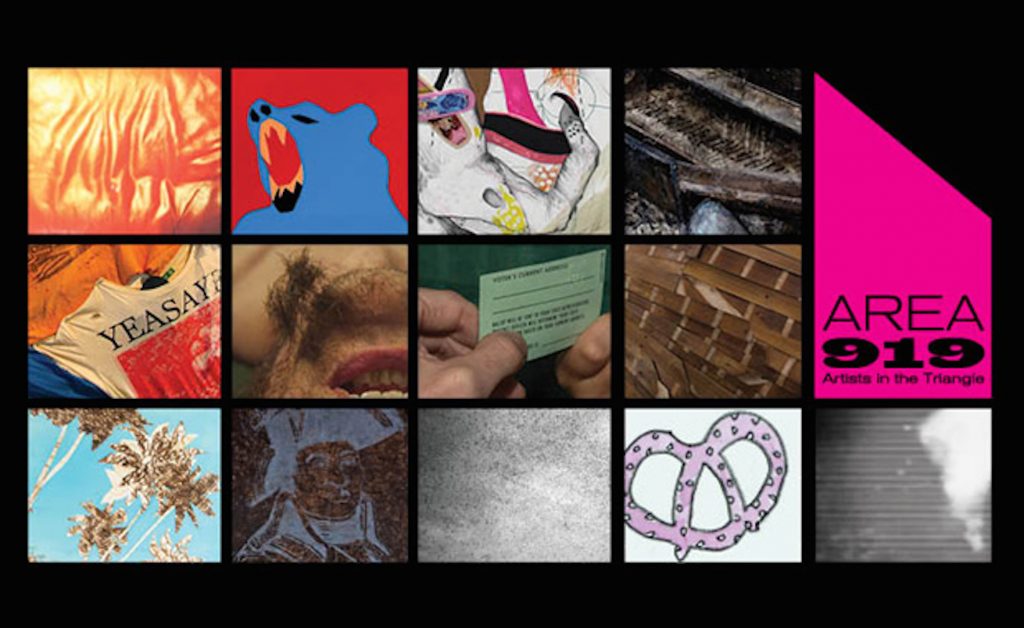Writing Area 919
I didn’t make it to the opening party for Area 919 last weekend, but I like to imagine that if I had, I’d have imitated the movements of a small child, insofar as I’d be playful and hop around but I would not—definitely not—touch the art. I’d bend over to peer through the open circles of Casey Cook’s undulating sculpture Whoa, Nelly! Through the holes my eyes would settle upon a painting on the opposite wall, which would mean they’d fixate on the dark grain of Damian Stamer’s Requiem. What at first looks like a contained interior scene—an abandoned piano, an old chair—slowly begins to expand: objects composed of scraped paint uncover other objects, until, hey, is that a tree branch up there? Looks like it. The wall placard explains that Stamer “create[s] haunting environments borrowed from the rural landscape of north Durham County, where he grew up.” I’m reminded of a recent holiday drive through north Durham, and then through Oxford, and then through southwest Virginia. I remember the darkness under the eaves of stately Oxford houses, which made me think about the riots Tim Tyson writes about in Blood Done Sign My Name. But I also remember how the sunset gathered on the long flat lawns outside the downtown, lawns abutting forests that looked like they could go on forever. If I could tie all that together in a painting, maybe it’d look—or feel—something like how Stamer’s looks and feels to me now.

In my opening remarks for this year’s Ethics Film Series, which began this week with The Visitor, I gave some background for the theme—“Sound Beliefs.” I’ve given this background before, in writing and in speech; I repeat it, like a mantra: I wanted to pick something, some things, that felt both tactile and complex. I use this phrase as if the two terms stand in opposition, but when I say it they always hang together. I felt the same urge as I stood between Cook’s sculpture and Stamer’s painting, and then again when I stood between Cook’s sculpture and Neill Prewitt and Yuxtapongo’s installation Exploded Hipster, whose contents—local band and record label shirts, a stray Converse shoe, all crowdsourced from the Triangle’s music community—snake outward on the white gallery wall. Tactile, yes; they’re t-shirts, once hugged by warm bodies, some of whom I probably know personally, many of whom I probably follow on Twitter. I imagine a landscape of friendship and artistry, idiosyncratic and colorful, abstract and necessarily unfamiliar, to a certain degree (i.e., who did that Merge t-shirt belong to? Ah, yes, we’ve once made eye contact). But I also see that landscape, in front of me. I almost want to stick my arm through, to try it on for a while.
Area 919 is powerful in its assertion of a creative world through the hanging together of multiple creative worlds. This is something that art, and its curation, do well. “All of [the artists of Area 919] contribute to a vibrant and innovative artist community, helping to establish the Triangle as a growing creative center,” the exhibition detail reads. In effect, that exhibition detail is writing the community into a space, just as its artists are writing, painting, molding, imaging their selves, and their works, into a space. I feel similarly when I read the words of the women featured in “A Food Sisterhood Flourishes in North Carolina,” and the words of the many commenters, insisting that the New York Times should have included another woman chef, another women-helmed restaurant, to more holistically honor the vibrancy of North Carolina’s food scene. That web would look different, yes—as it would look different, from the get-go, from any one chef’s, or artist’s, perspective. And so it would from yours or mine.
It’s possible, but not easy, to build community on the foundation of diversity; it’s possible, but even less easy, for that sense of community to be validated externally in a way that feels fair, representative, and holistic to those who did the work in the first place. And yet that is the work that remains: the getting up in the morning, the painting, the writing, the meeting people, the attending (or not attending). The pieces included in Area 919 honor that work by bringing different worlds together in one space: so tactile that you, and you, and you, can peer through the circles, too.
—MD
